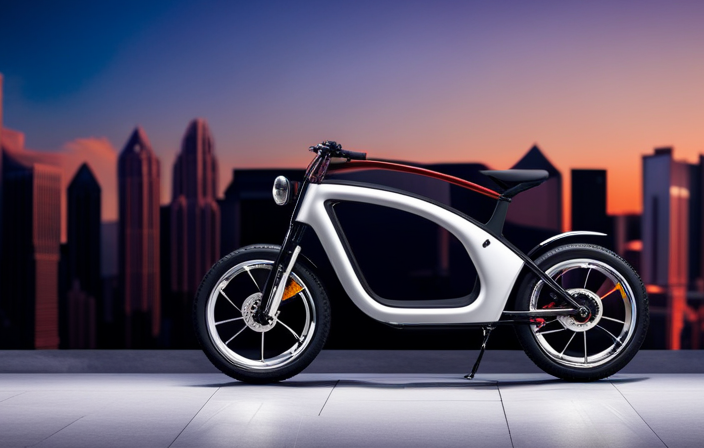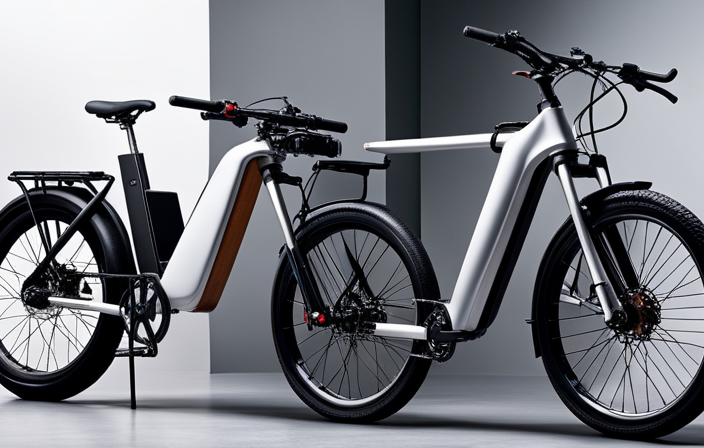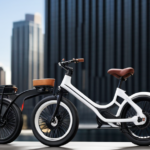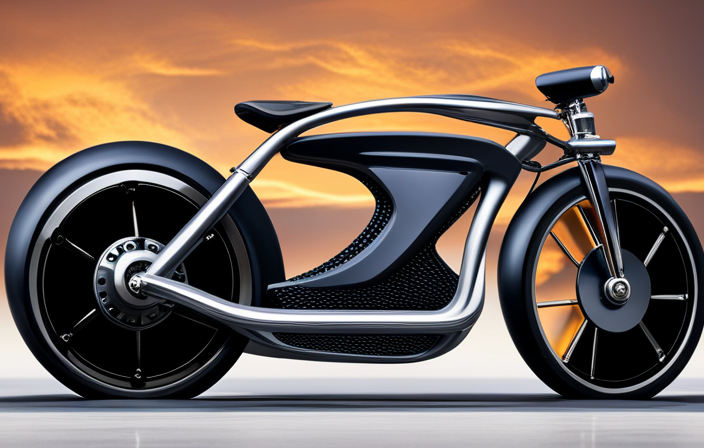Ever thought about the cost of an electric bike? Luckily, in this article, we will delve into the different factors that influence the price of electric bikes.
From the types of electric bikes available to the quality and brand reputation, motor power and battery capacity, frame material and design, and additional features and accessories, we will delve into all the essential aspects that contribute to the cost of an electric bike.
So, let’s dive in and find out how much you might need to budget for your dream electric ride.
Key Takeaways
- The cost of maintenance and repair for electric bikes can vary depending on the specific component or service required.
- The availability of comprehensive warranty coverage and good customer support is important for a positive ownership experience and long-term cost savings.
- Government incentives and subsidies can make electric bikes more affordable and promote sustainable transportation.
- Local market prices and availability, as well as the option of buying used electric bikes, can impact the overall cost of owning an electric bike.
Types of Electric Bikes Available
If you’re in the market for an electric bike, you’ll be amazed at the wide range of options available to suit your specific needs and preferences. Electric bikes come in various types, each offering unique features and advantages.
One key consideration is the type of electric bike motor. There are three main types: hub motors, mid-drive motors, and friction drive motors. Hub motors are the most common and are located in the wheel hub, providing a smooth and quiet ride. Mid-drive motors are situated in the bike’s crankshaft, offering better balance and control. Friction drive motors are attached to the bike’s rear wheel, providing a lightweight and affordable option.
Additionally, electric bikes have several advantages over traditional bikes. These include pedal assist for easier riding, reduced strain on joints, and the ability to cover longer distances.
Transitioning into the next section on quality and brand reputation, it’s important to consider these factors when making your electric bike purchase.
Quality and Brand Reputation
Renowned brands are known to deliver top-notch electric bikes, ensuring a smooth and exhilarating ride. When considering the quality and brand reputation of an electric bike, it is important to understand that these factors can greatly impact the overall cost.
Well-established brands often invest heavily in research and development, resulting in superior build quality, innovative features, and reliable performance. Consequently, the price of electric bikes from reputable brands tends to be higher compared to lesser-known brands. However, this higher cost is often justified by the added value and peace of mind that comes with a trusted brand.
Factors such as customer support, warranty coverage, and long-term durability are also important considerations when evaluating the cost of an electric bike.
Moving forward, it is important to also analyze the motor power and battery capacity, which play a crucial role in determining the performance and range of the electric bike.
Motor Power and Battery Capacity
To truly experience the exhilaration and power of an electric bike, you need to consider the motor power and battery capacity.
-
Motor Power Efficiency:
-
A higher motor power allows for faster acceleration and better performance on steep hills.
-
Look for bikes with efficient motors that maximize power output while minimizing energy consumption.
-
Battery Lifespan and Replacement Costs:
-
Consider the battery lifespan, as it determines how long you can ride before needing a replacement.
-
Look for bikes with batteries that have a long lifespan to avoid frequent replacements, which can be costly.
Considering motor power efficiency and battery lifespan is crucial when choosing an electric bike. Efficient motors provide a better riding experience, while batteries with a long lifespan reduce replacement costs.
Now let’s move on to the next section about frame material and design, where we’ll explore how these factors contribute to the overall performance and comfort of an electric bike.
Frame Material and Design
When choosing an electric bike, you’ll want to consider the frame material and design, as they significantly impact the performance and comfort of your ride.
Did you know that bikes with carbon fiber frames are 40% lighter than those with aluminum frames? Frame weight is an important factor to consider as it affects the overall agility and maneuverability of the bike. Additionally, carbon fiber frames tend to offer better shock absorption, resulting in a smoother ride.
On the other hand, aluminum frames are known for their durability and ability to withstand rough terrains. It’s crucial to find the right balance between frame weight and durability based on your riding preferences and intended usage.
Now, let’s move on to discussing additional features and accessories that can further enhance your electric bike experience.
Additional Features and Accessories
Imagine pedaling down the open road with the wind in your hair and the sun on your face, while effortlessly shifting gears with the smooth and precise electronic shifting system on your electric bicycle.
Electric bikes not only provide a convenient and eco-friendly mode of transportation, but they also offer a range of additional features and accessories that enhance the riding experience. Bike accessories such as fenders, racks, and lights can be added to electric bikes, providing practical benefits like protection from splashes, the ability to carry luggage, and increased visibility during nighttime rides. These additional features not only improve the functionality of the bike but also make the ride more enjoyable and convenient.
Transitioning into the next section about the range or distance covered per charge, electric bikes offer even more benefits.
Range or Distance Covered per Charge
Get ready to experience the freedom of exploring new horizons as you effortlessly cruise through long distances on your electric bicycle. One important factor to consider when choosing an electric bike is its range or distance covered per charge. This is determined by the battery capacity and efficiency.
Electric bikes typically have a range of 20-80 miles per charge, depending on various factors such as terrain, rider weight, and speed. It’s important to note that the range can vary and may be affected by factors like wind resistance and temperature.
Charging time is also an important consideration, as it determines how quickly you can get back on the road. Most electric bikes take around 3-6 hours to fully charge.
Additionally, the battery lifespan is an important factor to consider, as it affects the long-term cost of owning an electric bike.
Transitioning into the next section about speed and performance, let’s explore how electric bikes can provide an exhilarating ride.
Speed and Performance
Feel the thrill of the wind in your hair as you effortlessly soar through the streets on your electric bicycle, experiencing unmatched speed and performance.
When it comes to speed, electric bikes can vary depending on the model and battery life. Some e-bikes can reach speeds of up to 28 mph, allowing you to zip around town much faster than a traditional bicycle. However, it’s important to note that higher speeds can drain the battery faster, reducing the overall range or distance covered per charge.
Despite this trade-off, electric bikes are still considered to be environmentally friendly transportation options. They produce zero emissions and have a lower carbon footprint compared to cars or motorcycles.
As we explore maintenance and repair costs, you’ll see that owning an electric bike is not only exhilarating but also cost-effective in the long run.
Maintenance and Repair Costs
Moving on from discussing the speed and performance of electric bikes, let’s now delve into the topic of maintenance and repair costs. It is important to consider these factors when evaluating the overall cost of owning an electric bike. Regular maintenance is essential to keep your bike running smoothly and extend its lifespan. Some maintenance tips include keeping the battery charged, cleaning and lubricating the chain, and regularly checking tire pressure. Common repair issues that may arise include brake adjustments, replacing worn-out tires, and fixing electrical components. To give you a better understanding of the potential costs involved, here is a table outlining some common maintenance and repair expenses for electric bikes.
| Maintenance/Repair | Average Cost |
|---|---|
| Battery Replacement | $200 – $600 |
| Brake Adjustment | $20 – $50 |
| Tire Replacement | $30 – $60 |
| Electrical Component | $50 – $150 |
| Cleaning/Lubrication | $10 – $20 |
As we explore further, let’s now move on to the next section where we will discuss the importance of warranty and customer support in the electric bike industry.
Warranty and Customer Support
Warranty and customer support are crucial factors to consider when evaluating the overall ownership experience of an electric bike. Here are three reasons why they are so important:
-
Warranty coverage: A comprehensive warranty can provide peace of mind, knowing that any potential issues with your electric bike will be taken care of. Look for warranties that cover both the frame and the electrical components for a specified period of time.
-
Customer satisfaction: Good customer support is essential for a positive ownership experience. Whether it’s answering questions, helping with troubleshooting, or providing assistance with repairs, responsive and helpful customer support can make a big difference.
-
Long-term cost savings: A solid warranty and reliable customer support can help reduce maintenance and repair costs in the long run. With proper coverage and assistance, you won’t have to worry about expensive repairs or replacement parts.
Considering these factors, warranty coverage and customer satisfaction play a crucial role in the overall electric bike ownership experience.
Moving forward, let’s explore the next section about government incentives and subsidies.
Government Incentives and Subsidies
Government incentives and subsidies can greatly impact the affordability and accessibility of electric bikes. Many governments around the world provide financial incentives to encourage the adoption of electric bikes as a means of sustainable transportation. These incentives can include tax credits, rebates, or even direct subsidies for purchasing electric bikes.
By reducing the upfront cost of an electric bike, these incentives make them more affordable for consumers. Moreover, these incentives also help promote the environmental benefits of electric bikes, such as reducing carbon emissions and decreasing air pollution. By encouraging the use of electric bikes, governments aim to create a more sustainable and cleaner transportation system.
Transitioning to the subsequent section about ‘local market prices and availability’, it is important to consider the impact of these incentives on the overall cost of electric bikes in different regions.
Local Market Prices and Availability
Now that we’ve discussed government incentives and subsidies for electric bikes, let’s take a closer look at local market prices and availability.
The local market competition plays a significant role in determining the cost of electric bikes. Different bike shops offer varying prices based on factors such as brand reputation, features, and after-sales services. Customer preferences also influence the pricing structure. Some customers prioritize high-end features and are willing to pay a premium price, while others may opt for more affordable options.
In terms of availability, it’s important to consider that popular models may have limited stock, leading to higher prices due to increased demand.
Understanding the local market and customer preferences is crucial in determining the cost of electric bikes.
Moving forward, let’s explore another option for purchasing electric bikes – second-hand or used options.
Second-hand or Used Options
If you’re on a budget or seeking a unique ride, exploring second-hand or used options can be a great way to score a bargain and embrace the thrill of the hunt.
There are several advantages of buying second hand electric bikes. Firstly, you can save a significant amount of money compared to purchasing a brand new one. Secondly, you have a wider range of options available as you can consider older models that may no longer be in production.
However, there are a few factors to consider when buying used. It’s important to thoroughly inspect the bike for any damage or wear and tear, especially on the battery and motor. Additionally, check the bike’s maintenance history to ensure it has been well taken care of.
Transitioning into the subsequent section about financing and payment plans, it’s worth noting that some sellers may offer payment options for used electric bikes as well.
Financing and Payment Plans
You’ll be amazed at how easy it is to get your hands on the perfect electric ride with the incredible financing options and convenient payment plans available.
When it comes to financing options, there are multiple choices to suit your needs.
-
Bank Loans: Many banks offer loans specifically for purchasing electric bikes, with competitive interest rates and flexible repayment terms.
-
Manufacturer Financing: Some electric bike manufacturers provide financing options directly, making it even more convenient to get the bike you want.
-
Retailer Financing: In addition to manufacturer financing, many bike retailers offer their own financing plans with low or no interest.
With these payment flexibility options, you can easily budget for your electric bike without feeling overwhelmed.
Now, let’s explore the long-term cost savings that come with owning an electric bike.
Long-term Cost Savings
One can experience significant savings over time by owning an electric bike due to reduced maintenance and fuel expenses. Electric bikes are highly energy efficient and require minimal maintenance compared to traditional bikes or cars. With no need for gas or oil, the only ongoing cost is the electricity needed to charge the battery, which is significantly cheaper than fuel.
Additionally, electric bikes have a much lower environmental impact than cars, reducing greenhouse gas emissions and air pollution. By choosing an electric bike as a mode of transportation, not only can individuals save money but also contribute to a cleaner and healthier environment.
Considering these long-term cost savings and environmental benefits, electric bikes are a practical and sustainable choice for budget-conscious individuals.
Transitioning to the next section, it is important to consider personal budget and needs when purchasing an electric bike.
Considerations for Personal Budget and Needs
Surprisingly, choosing the right electric bicycle that suits your personal budget and needs can be a real head-scratcher. When considering your personal budget, it’s important to think about the initial cost of the electric bike, as well as any additional accessories or maintenance expenses that may arise. Keep in mind your personal preferences, such as the type of terrain you’ll be riding on and the distance you plan to travel. This will help determine the battery range and power output you require.
Additionally, consider the environmental impact of your choice. Electric bikes are a greener transportation option compared to traditional vehicles, but it’s essential to research the manufacturing process and materials used in the bike to ensure it aligns with your sustainability goals.
Overall, finding the perfect electric bike involves careful consideration of your personal budget and needs, as well as the environmental impact of your choice.
-
Personal Budget Considerations:
-
Initial cost of the electric bike
-
Additional accessories or maintenance expenses
-
Personal Preferences Considerations:
-
Type of terrain
-
Distance to be traveled
Frequently Asked Questions
Are there any government incentives or subsidies available for purchasing an electric bike?
Yes, there are government incentives and subsidies available for purchasing an electric bike. These incentives and subsidies can help reduce the overall cost of an electric bike, making it a more affordable option for consumers.
What are the considerations for personal budget and needs when buying an electric bike?
When considering an electric bike purchase, I focus on my personal preferences and the best electric bike brands. By analyzing features, performance, and reviews, I can make an informed decision that aligns with my needs.
Can I find second-hand or used electric bikes in the market?
Finding reliable sellers is important when looking for second-hand electric bikes. However, there are advantages to buying a new electric bike, such as warranty coverage and the latest technology.
What financing and payment plans are available for purchasing an electric bike?
Financing options and payment plans for electric bikes vary depending on the seller and your credit history. Many bike shops offer financing through partnerships with banks or credit companies, while others may offer layaway or installment plans.
How can I save on long-term costs when owning an electric bike?
To save money on long-term costs when owning an electric bike, it’s important to prioritize regular maintenance. By keeping the bike in good condition, you can prevent expensive repairs and extend its lifespan.
Conclusion
In conclusion, when considering the cost of an electric bike, there are various factors to take into account. From the types available to the quality and brand reputation, motor power and battery capacity, frame material and design, to additional features and accessories, all contribute to the overall price.
However, investing in an electric bike is like having a trusty steed that effortlessly glides through traffic, making your daily commute a breeze. So, while the initial cost may seem steep, the long-term cost savings and convenience make it a worthwhile investment.
















